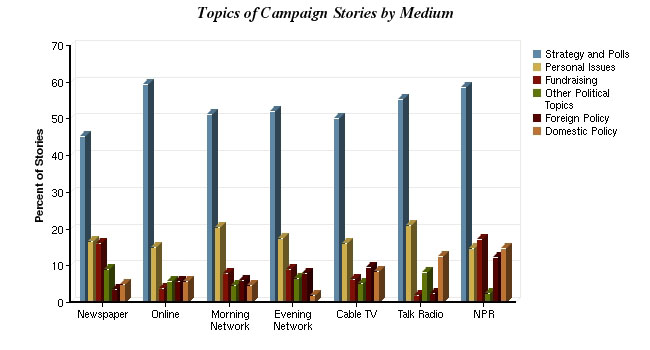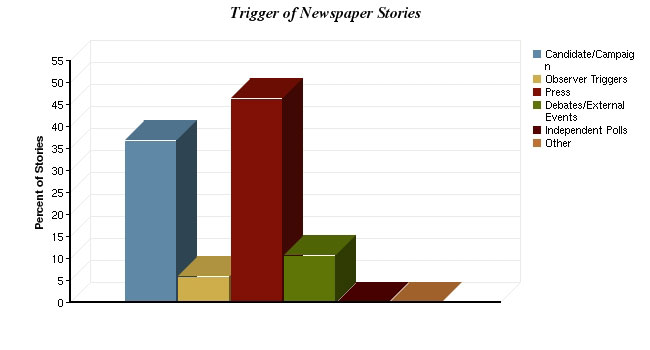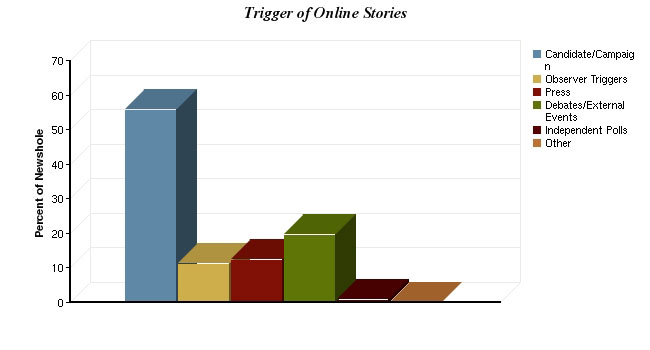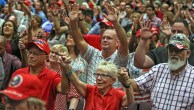Did different media cover the campaign differently? Increasingly, PEJ’s New Index finds striking differences in how different media sectors approach the news. The campaign offers yet another case of this.
But one feature was consistent across all sectors—the focus on the horse race, polling and strategy.
Newspapers—More Enterprise and Emphasis on Governance
On the front pages of newspapers, Democrats tended to get more coverage than in other media, somewhat more positive coverage than elsewhere, and more stories tended to contain information that explained how they would be affected if that candidate were elected than was true in the press coverage overall. In addition, many more of the stories were initiated by journalists than elsewhere in the press, a fact that signals a special role for print as a source of enterprise in news.
The PEJ-Shorenstein study included 11 newspapers, examining front-page coverage.
Looking just at topic, those stories tended to be focused more on political matters and less on issues and ideas than the media overall. In all, 71% of newspaper stories concentrated on the “game,” compared with 63% overall. And 8% of front-page newspaper stories were about policy, vs. 15% generally. Newspapers were typical of all media studied for their focus on the personal backgrounds of candidates (17%).
Whatever the topic, however, newspapers tended to frame stories more in terms of their impact on voters than did other media. Fully 18% of newspaper stories were framed around how the information might be relevant to citizens, compared with 12% in the press generally.
Another distinguishing characteristic of the print stories studied was tone. Democrats got much more positive coverage in the daily papers examined than they did elsewhere. Fully 59% of all stories about Democrats had a clear, positive message vs. 11% that carried a negative tone. That is roughly double the percentage of positive stories that we found in the media generally. Just under a third (30%) of the front page stories examined were neutral.

For the top tier Democrats, the positive tilt was even more the case than for Democrats in general. Obama’s front page coverage in the sample was 70% positive and 9% negative and Clinton’s was similarly 61% positive and 13% negative.
Republican candidates, in contrast, were more likely to receive clearly negative stories in print than elsewhere: 40% negative vs. 26% positive and 34% neutral.
Newspapers also stood out for initiating more campaign coverage on their own. Nearly half of all front page stories were triggered by newsroom initiative rather than reacting to what the candidate or others said or did (46%). That is substantially higher than the 28% in the media generally in the sample. A little more than a third of stories were triggered by the candidates and their campaigns (37%), compared with 46% generally.
There was also some good news for second-tier candidates in print. These candidates were able to make news in smaller newspapers, sometimes as the secondary figure in a story, to a greater extent than we found in other media.
There was another way some of these less-heavily-covered White House aspirants got attention. They found their way into newspapers through hometown coverage. New Mexico Governor Bill Richardson had this advantage in Albuquerque, for instance. So did Fred Thompson in Chattanooga. In theory, such coverage may mean more in the Internet Age than it once did. Those locally produced stories can find their way into more widely distributed environments online, whether it is the major aggregators like Google, or political aggregation sites like Real Clear Politics, or through links in blogs or elsewhere. To what extent that may be happening is harder to tell.
Online—Keeping It in Neutral
The online news sites in the PEJ-Shorenstein study were among the least likely outlets to initiate their own stories, and tended to be more neutral in their coverage, and notably less negative.
The study included five online news sites, including CNN.com, Yahoo News, Google News, MSNBC.com, and AOL news. The sample studied the top five stories each day on each site, or 106 campaign stories in total.
The topics people would find there were fairly typical, though the percentage of stories about strictly political matters was slightly higher than the norm (69% vs. 63% overall). More coverage of the polls was one reason (59% vs. 50% for the press generally), but there was less coverage of fundraising than the norm (4% vs. 7% overall).
The online news sites studied demonstrated the least enterprise of any medium studied. Just 12% of the top stories online were initiated by the press, compared with 28% of the media overall. Conversely, more of the stories were triggered by something the candidates themselves said or did, or by debates or outside matters.
It is important to note that of the five online news sites in the study, only CNN and MSNBC are part of a newsgathering operation, while Yahoo and Google are primarily news aggregators. AOL has made some efforts at news gathering, with uneven success.
Another explanation is that the web audience depends on this platform for up-to-the-minutes news. Therefore these outlets are oriented toward immediacy and breaking news. In this medium, the newest event might gravitate to the top of the web page.
A focus on breaking news might also explain another difference online. The websites studied were more likely than other media to focus on the horse race. Fully 59% of stories were about strategy, momentum, polls and the race, compared with 50% in the press overall.
The news sites examined also stood out in part for the degree of neutrality. Fully 53% of top stories online were neutral, compared with 39% of the media overall. And just 15% were clearly negative in tone, vs. 30% for the media generally.
Another distinction was in who got covered. Online, Barack Obama was the most covered candidate, not Hillary Clinton. The Illinois Senator was the focus of 19% of all election stories vs. 10% for Clinton and 11% for Giuliani.
Evening News—NBC’s Election Coverage Differs from Others
Once, the evening network newscasts may have been the single most important media target for someone aspiring to the presidency. Even now, with 20 million viewers, a median audience age of roughly 60 years (a solid voting group) and an audience demographic that mirrors the population generally across party and ideology, the network evening newscasts are still an important venue.

The campaign received substantial coverage—154 stories over the course of 109weeknights.
When it came to topic, network nightly news was more strategic and less policy oriented, than the press overall, or than its rival, cable news. Fully 68% of those stories were about internal political matters (mostly strategy and the horse race), while 18% were about personal concerns involving the candidates (marriage, religion, health), and 10% were about issues.
Network evening news closely reflected the overall media when it came to dividing time between Democrat and Republican candidates (49% vs. 28%). While all three produced more stories about Democrats than Republicans, at the NBC Evening News the gap was smaller—just an 11 percentage point difference (41% Democrats vs. 30% Republicans) vs. roughly a 30 percentage point gap at ABC and CBS.

The tone of coverage in the 30-minute evening newscasts was much more positive toward the Democrats than Republicans. And again, among the major candidates, Obama got the best of it and McCain the worst. Of the 11 stories primarily about McCain that ran on the nightly news in the first five months of the year, not a single one carried a clearly positive tone. Six of them were clearly negative and five were neutral.
The commercial over-the-air TV networks did not focus on second tier candidates at all, except for Bill Richardson when he announced (and Joe Biden when he made controversial comments about Obama). PBS was the only network in which any other 2nd tier candidates was successful as a newsmaker.
Network Morning New—Sunrise Shows Feature Obama and Romney
Network TV news coverage in the morning was strikingly different than in the evening.
To begin with, the morning shows covered the race more heavily than their evening siblings. Over the same number of minutes and days, morning news did 265 segments (about 11 hours) on the campaign, compared with 154 at the dinner hour (about five hours).
There were also distinct differences by network. The Today show aired the most campaign stories (110 stories vs. 81 on Good Morning America and 74 on CBS’ Early Show).
CBS’ Early Show was the most heavily focused on the horse race and other strategic matters (77% of its stories, vs. 61% on Today and 56% at GMA).
Good Morning America and Today were more likely do stories on the personal side of the race (28% of stories on GMA vs. 20% at Today and 12% on CBS).
And certain subjects proved particularly attractive to morning producers. Nearly half of the stories on GMA about personal matters, for instance, involved Elizabeth Edwards and her battle with breast cancer.
Within that time frame, the shows produced almost twice as many stories focused on Democratic candidates than on Republicans (51% vs. 27%).
PBS –More Attention to the “Other” Hopefuls
The NewsHour with Jim Lehrer on PBS stood out from the media overall and the three commercial evening newscasts in particular on several levels. First, the program gave the 2008 election much lower priority in the news, at least in the first half-hour of the newscast studied here. Not one campaign story from January through May aired among the top three stories in any PBS newscast. In contrast, on the three commercial nightly newscasts (CBS, ABC, and NBC) roughly 30% of the stories appeared in that top part of the newscast.
Second, the NewsHour stood out for the attention it devoted to lesser-known candidates. While the media overall, focused heavily on the top few candidates in each party,the first 30 minutes of the NewsHour spread coverage across a much broader group of contenders. The only candidate to stand out from the group in total coverage was John McCain, who was the focus of 11% of the election stories.

Otherwise, top candidates Barack Obama and Rudy Giuliani were the primary figures for just a single story each, as were lesser-known candidates Chris Dodd, Joe Biden, Bill Richardson, and Tom Tancredo. (Hillary Clinton had two stories in all.)
The program also tended more than other media toward comparative summaries of multiple candidates rather than piece focused one candidate at a time. Fully 40% of the stories on the NewsHour did not highlight one particular candidate but focused on several or discussed other subjects like voting issues. Much of this may be explained by the NewsHour’s emphasis on the four debates that occurred in this time period. They accounted for 17% of the outlet’s election stories, more than any other storyline and seven percentage points more than the media overall (10%).
[2]
Cable – Republicans get their friendliest coverage
On cable, the campaign was a bigger story than in other media and was more positive toward Republicans than in any sector other than online.
Overall, according to PEJ’s News Coverage Index, the campaign made up 10% of the newshole on cable TV during the first five months of the year, compared with 8% overall.

Despite the time it had to fill, cable news did not stand out for the range of topics it covered, in its greater interest in Democrats or even much in the candidates it covered.
What distinguished cable news more in the first five months of the year was the tone of the coverage. The positive-negative breakdown of Democrats followed roughly the same trend as the media overall (34% positive vs. 25% negative). But the tone of Republican coverage was quite different. On cable TV, stories about Republican candidates were nearly as likely to be positive as to be negative (29% positive vs. 30% negative).
But those numbers only reflect the three major cable news channels taken together. When you look at the coverage of each one, there are significant differences in how the candidates were treated. CNN gave decidedly more negative coverage to Republican candidates; Fox was more negative towards Democrats–and more positive towards Republicans; MSNBC gave decidedly positive coverage towards both.
CNN: The CNN programming studied tended to cast a negative light on Republican candidates—by a margin of three-to-one. Four-in-ten stories (41%) were clearly negative while just 14% were positive and 46% were neutral. The network provided negative coverage of all three main candidates with McCain fairing the worst (63% negative) and Romney fairing a little better than the others only because a majority of his coverage was neutral.
It’s not that Democrats, other than Obama, fared well on CNN either. Nearly half of the Illinois Senator’s stories were positive (46%), vs. just 8% that were negative. But both Clinton and Edwards ended up with more negative than positive coverage overall. So while coverage for Democrats overall was a bit more positive than negative, that was almost all due to extremely favorable coverage for Obama.
Fox News: The programming studied on Fox News offered a somewhat more positive picture of Republicans and more negative one of Democrats compared with other media outlets. Fox News stories about a Republican candidate were most likely to be neutral (47%), with the remainder more positive than negative (32% vs. 21% negative). The bulk of that positive coverage went to Giuliani (44% positive), while McCain still suffered from unflattering coverage (20% positive vs. 35% negative).

When it came to Democratic candidates, the picture was more negative. Again, neutral stories had a slight edge (39%), followed by 37% negative and 24% positive. And, in marked contrast from the rest of the media, coverage of Obama was twice as negative as positive: 32% negative vs. 16% positive and 52% neutral.
But any sense here that the news channel was uniformly positive about Republicans or negative about Democrats is not manifest in the data.
MSNBC: On MSNBC, a positive tone pervaded coverage of candidates from both parties. Nearly half (47%) of the stories about Democratic candidates were positive, vs. 19% negative and 34% neutral. Coverage of Republican candidates was not quite as rosy but still more stories were positive (38%) than neutral (33%) or negative (30%).
But here as well, Senator McCain still came up short. Four-in-ten of his stories (39%) were negative in tone compared to only about two-in-ten (22%) that were positive.
Talk Radio—Accentuating the Negative
It may surprise no one that the 2008 presidential election was a major feature of talk radio, both conservative and liberal. From January through May, the race for the White House has accounted for 13% of the total airtime studied, making it the second-biggest story after the debate over Iraq policy (17%). Overall, conservative talk radio was far more interested in the early campaign than was liberal talk radio. Conservative talk radio aired 106 segments on the candidates, while liberal talk radio mustered a bare 29 segments.
Most of that airtime was spent dwelling on the negative. Conservatives spent the bulk of their time criticizing Democratic candidates and liberal hosts vented about Republican contenders. The candidate who received the most attention by far on talk radio was Senator Clinton. She got two or three times the attention of any other contender regardless of party. Most of the Clinton segments were carried on conservative talk radio, which covered her negatively in 86% of 50 segments. The most discussed Republican candidate on liberal talk radio, Mayor Giuliani, was treated negatively in every segment about him, but there were only eight.

What also stood out was the treatment of candidates who might be from the hosts’ own political camp. Even here there was a tendency to find fault. More than half (56%) of the conservative talk segments about Republican Rudolph Giuliani carried a negative tone as did half of the those on conservative talk radio about John McCain. Liberal hosts were twice as likely to be negative as positive about their leading candidate, Hillary Clinton. A third (33%) of the segments about her were negative, vs. 17% that were positive and 50% neutral).
No talker was more critical than conservative host Michael Savage, who has talked about running for President himself. Only one election-related story out of the entire five-month period on his show was positive and that was a self-referential story about John McCain. Savage discussed how he had met McCain at a fight in Las Vegas, and how he offered the candidate advice. All other coverage about liberal or conservative candidates carried a clear negative tone.
On the liberal side, Randi Rhodes was both the most partisan and the most negative toward Republicans. The one election segments spent on Democratic candidates was clearly positive while all but one the 15 segments on Republicans were critical.
NPR—Morning Edition – more time for the Democrats
Like the media overall, the first 30 minutes NPR’s Morning Edition produced more stories about Democratic candidates than Republicans (41% vs. 24%). What was different was how little negative coverage Democrats received, especially compared with all other media. Stories about a Democratic candidate were more seven times more positive than negative: 41% positive vs. 6% negative. The majority of coverage, 53% of stories, was neutral.

Looking at specific candidates, stories about Barack Obama carried a clearly positive tone two-thirds of the time. Not a single Morning Edition story was negative. Furthermore, 43% of Hillary Clinton’s coverage was positive vs. 14% negative.
Stories about one of the Republican candidates was more evenly split in tone: 30% positive to 20% negative and 50% neutral. Similar to its public broadcasting counterpart, the NewsHour, NPR devoted more attention to lesser-known candidates. Mitt Romney, the candidate running third for the GOP nomination in most national polls, was the most covered Republican figure, tied with Mike Huckabee, a mostly unknown candidate at the time. Often considered the GOP front runner, Rudy Giuliani, only had one story devoted to him and John McCain had none.
NPR was also the one outlet where there was a marked difference between the total amount of airtime vs. total number of stories. While 24% of the campaign stories were about a Republican candidate, just 15% of the total airtime was spent on them. This suggests that stories about the Republican candidates were brief, creating an even greater gap in the total coverage of Republicans and Democrats.
[1]The study examined the first half hour of the three morning programs, the time when the programs are far more likely to cover traditional news than later in the broadcast, when the topic turns more to lifestyle, features, shopping and cooking.
[2] For early findings about the PBS NewsHour, see the Network TV content analysis in the “2006 Annual Report on the State of the News Media,” “The Debate Effect: How the press covered the pivotal period” as well as the 2005 Annual Report on the State of the News Media.
[3] CNN also stood out for one other factor. Far more of its campaign stories were taped edited packages, the kind of traditional work that is even more a feature of broadcast evening news. Fully 40% of its segments were correspondent packages. On Fox, the number was 29%. MSNBC, despite its affiliation with NBC News, was the least likely to feature correspondent packages. Only 7% of its election segments were packages. Far more, 79% of all segments, were live discussions, either with staff or outside guests.



